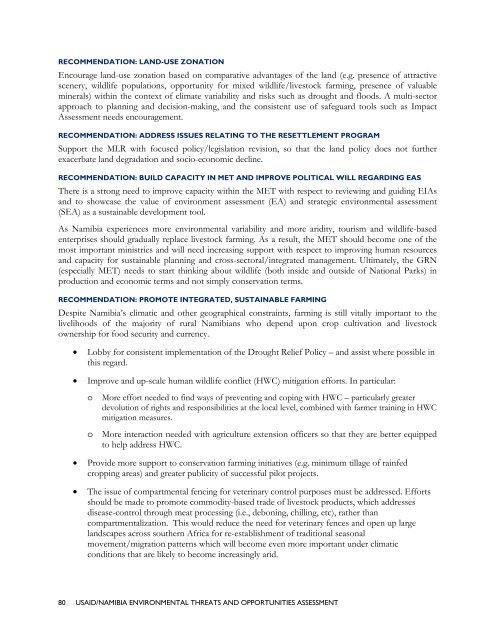usaid/nambia environmental threats and opportunities assessment
usaid/nambia environmental threats and opportunities assessment
usaid/nambia environmental threats and opportunities assessment
Create successful ePaper yourself
Turn your PDF publications into a flip-book with our unique Google optimized e-Paper software.
RECOMMENDATION: LAND-USE ZONATION<br />
Encourage l<strong>and</strong>-use zonation based on comparative advantages of the l<strong>and</strong> (e.g. presence of attractive<br />
scenery, wildlife populations, opportunity for mixed wildlife/livestock farming, presence of valuable<br />
minerals) within the context of climate variability <strong>and</strong> risks such as drought <strong>and</strong> floods. A multi-sector<br />
approach to planning <strong>and</strong> decision-making, <strong>and</strong> the consistent use of safeguard tools such as Impact<br />
Assessment needs encouragement.<br />
RECOMMENDATION: ADDRESS ISSUES RELATING TO THE RESETTLEMENT PROGRAM<br />
Support the MLR with focused policy/legislation revision, so that the l<strong>and</strong> policy does not further<br />
exacerbate l<strong>and</strong> degradation <strong>and</strong> socio-economic decline.<br />
RECOMMENDATION: BUILD CAPACITY IN MET AND IMPROVE POLITICAL WILL REGARDING EAS<br />
There is a strong need to improve capacity within the MET with respect to reviewing <strong>and</strong> guiding EIAs<br />
<strong>and</strong> to showcase the value of environment <strong>assessment</strong> (EA) <strong>and</strong> strategic <strong>environmental</strong> <strong>assessment</strong><br />
(SEA) as a sustainable development tool.<br />
As Namibia experiences more <strong>environmental</strong> variability <strong>and</strong> more aridity, tourism <strong>and</strong> wildlife-based<br />
enterprises should gradually replace livestock farming. As a result, the MET should become one of the<br />
most important ministries <strong>and</strong> will need increasing support with respect to improving human resources<br />
<strong>and</strong> capacity for sustainable planning <strong>and</strong> cross-sectoral/integrated management. Ultimately, the GRN<br />
(especially MET) needs to start thinking about wildlife (both inside <strong>and</strong> outside of National Parks) in<br />
production <strong>and</strong> economic terms <strong>and</strong> not simply conservation terms.<br />
RECOMMENDATION: PROMOTE INTEGRATED, SUSTAINABLE FARMING<br />
Despite Namibia’s climatic <strong>and</strong> other geographical constraints, farming is still vitally important to the<br />
livelihoods of the majority of rural Namibians who depend upon crop cultivation <strong>and</strong> livestock<br />
ownership for food security <strong>and</strong> currency.<br />
<br />
<br />
Lobby for consistent implementation of the Drought Relief Policy – <strong>and</strong> assist where possible in<br />
this regard.<br />
Improve <strong>and</strong> up-scale human wildlife conflict (HWC) mitigation efforts. In particular:<br />
o<br />
More effort needed to find ways of preventing <strong>and</strong> coping with HWC – particularly greater<br />
devolution of rights <strong>and</strong> responsibilities at the local level, combined with farmer training in HWC<br />
mitigation measures.<br />
o More interaction needed with agriculture extension officers so that they are better equipped<br />
to help address HWC.<br />
<br />
<br />
Provide more support to conservation farming initiatives (e.g. minimum tillage of rainfed<br />
cropping areas) <strong>and</strong> greater publicity of successful pilot projects.<br />
The issue of compartmental fencing for veterinary control purposes must be addressed. Efforts<br />
should be made to promote commodity-based trade of livestock products, which addresses<br />
disease-control through meat processing (i.e., deboning, chilling, etc), rather than<br />
compartmentalization. This would reduce the need for veterinary fences <strong>and</strong> open up large<br />
l<strong>and</strong>scapes across southern Africa for re-establishment of traditional seasonal<br />
movement/migration patterns which will become even more important under climatic<br />
conditions that are likely to become increasingly arid.<br />
80 USAID/NAMIBIA ENVIRONMENTAL THREATS AND OPPORTUNITIES ASSESSMENT

















